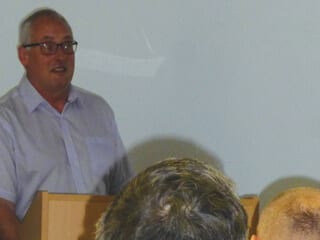
Latest News, North East Branch
The second branch meeting of the year was held on 27 April at the Rosen UK facility in Gosforth. The well attended meeting included David David Mobbs (chairman London branch) and the President of Institute of Corrosion, Sarah Vasey.
Malcolm Morris, Technical Support Manager Sherwin Williams, presented an in depth technical review of ISO standards and detailed the process that is undertaken in various levels of standards’ committees – local, national and international. ISO committees can be split down into, Technical committees – TC’s, Sub committees – SC’s and Working Groups – WG’s. However there are also other groups which can influence the development of standards namely, IPPIC – International Paint & Printing Ink committee and CEPE – European Confederation of Paint and Ink Manufacturers. In particular, Malcolm updated the audience on the current changes to the ISO 12944-6 standard with regard to updating the performance requirements for the various environments.
Many members of the audience were unaware that there were so many steps to go through to get modifications made to standards, and the description of the current process was very informative. There were numerous questions from the audience relating to the correlation of anticorrosive testing in the laboratory with actual field data. There were definite concerns that there was indeed no correlation and therefore how could the data be relied upon. It became very evident that the key to understanding the performance of coating was still looking at ‘track record’ of coatings in a particular environment. The comments from the meeting really showed what an emotive topic this is, and how much it matters to get these standards right.
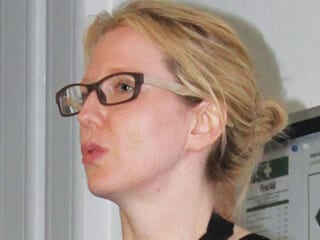
Latest News, London Branch
March was the Branch’s AGM, and reports were given by the outgoing chairman, Jim Gynn and the hon treasurer, Mike Allen. The branch had completed a full and successful meetings programme at their new venue, Imperial College, where they have started to see an increase in attendance with the average up from 30 to 50. The accounts showed a healthy surplus, and funds would be returned to the headquarters account. David Mobbs was elected as the new chairman with George Winning as vice-chair. Jim also thanked, John O’Shea, Mike Allen, Geoff White, Mash Biaglioli and David Dore, who have all stepped down from the committee, after giving long service to the branch.
After the AGM, Sarah Vasey, the President, gave a presentation about the Institute and its work, which included presentations on an up-date to Corrosion Management, Young ICorr and its aims, and the Route to Chartered Status.
Sarah started with a description of the Institute and how it is made up, including Council, Branches and Divisions, then described the awards, the Quality System, and website. The section on the Council introduced the trustees of the Institute and how they are linked to the larger Council. The members of Council and their roles were then discussed. The work of the Council involves driving a number of initiatives in which the various Branches have been heavily involved in. CED was then introduced and the role it plays within the Institute discussed, including a promotion of the upcoming CED day. It is perhaps not well known that the Institute gives out various awards and the requirements to be a recipient of these were described. Sarah discussed the implementation of the ISO 9001 quality system at Head Office and finally she mentioned the update to the website that is taking place to make it more useful to members.
The editor gave a brief up-date on the new format of Corrosion Management which had been redesign to make it easier to read, and also to include more technical articles and news relevant to the members. Chris Bridge described the young ICorr initiative, which continues the work started with the Young Engineer program, to promote the Institute to a younger generation. The section is aimed at the 35 and under age group, but not exclusively, and as part of the process there will be events for this group to attend and hopefully branch events can be aimed at the Young ICorr members in the future. The final subject of the evening was presented by Don Harrop on “The Route to Chartered Status” via the Institute of Corrosion. We are trying to encourage Engineers to get their Chartership through the Institute, and to achieve this, a mentoring program is currently being established with experienced professionals leading them through the process so they can understand the requirements needed to achieve Chartered Status. The program is aimed to go live in September 2017, so potential candidates should put their name forward to, david.mobbs@akzonobel.com.
The evening finished with a lively question and answer session and then the usual London networking session.
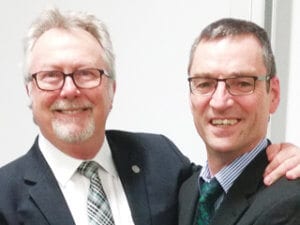
The new Branch chair, David Mobbs, welcomes Jim Britton as speaker.
The April meeting featured a presentation by Jim Britton, President and CEO of Deepwater Corrosion Services, on “Some Recent Offshore Cathodic Protection Life Extension Projects – So What’s New”.
Jim has worked in the Offshore Corrosion business since 1973, and for the last 17 years focussed on Asset Integrity and in particular Life Extension.
He described six current offshore projects which were challenging from a technical, and of course a financial perspective with owner operators who are reluctant to spend money on assets that are getting towards the end of their life. These included using using a novel series of anode belts, and utilising a novel clamp arrangement, which did not require welding, and which could be installed using an ROV, to attach new anodes to a concrete weighted pipe associated with platforms in Malaysia, where diver intervention would also be cost prohibitive.
A fully retractable suspended ICCP anode system was designed for a very old FSO in the Irish Sea, which would not be affected by inclement weather, and the largest ICCP retrofit to a single structure in the North Sea, and the first use of a containerised power supply system because of the lack of deck space. Interestingly there were members in the room who were involved in the original design which was to provide corrosion protection for 25 years, and it actually lasted 40 years.
There were a number of takeaways from this excellent presentation, but one of the major points was that whilst there are Codes of Practice for new build, there are no codes for retro- fit projects.
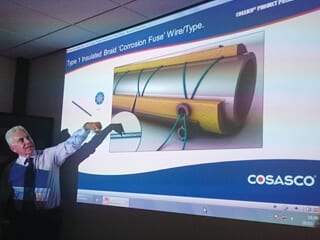
Aberdeen Branch, Latest News
The third meeting of 2017 was held on Tuesday the 28th March, with 28 attendees representing major companies including Atkins, BP, CNR, DNV GL, Lloyds Register, Oceaneering, Subsea 7, TOTAL and Wood Group.
The event was an industrial visit to the premises of Cosasco Europe HQ in Aberdeen, to hear about the latest Advances in Probe and Coupon Monitoring and Safe Access / Retrieval of Data, with many live demonstrations being performed.
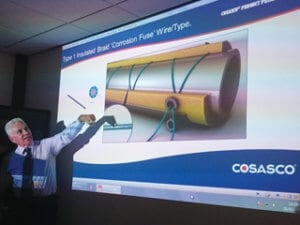
Derek Morton explains the concept of under insulation monitoring
Specialist equipment for solids erosion tracking and production well management was also illustrated. Solids determination to minimise erosion and determine the solids-free flow rate is considered essential practice for maximising equipment life. A lively debate followed the speaker presentation with many questions from the audience.
There were opportunities later to inspect at close hand, a wide range of advanced electronic sampling tools and data reporting systems, with Cosasco consultants and Engineers including, Andy Allan, Mark Maulvaney, Richard Rae, James Taylor, Sandy Tweddle and Dean Smith (Aberdeen Base Manager), all on hand to explain how such devices can be optimised to best advantage.
The activities that followed the technical presentation included informative demonstrations of pressurised retrieval operations of data logging devices, wireless monitoring technologies, probe and chemical monitoring applications and safety isolation devices. There were also a number of poster displays and the wide range of models and test rigs certainly kept the attention of the branch members throughout the evening. Advanced monitoring probes were displayed, including those intended specifically for laboratory use such LPR devices. The differing sensitivity and speed of available probes was clearly demonstrated, along with their most commonly used applications, e.g. Galvanic for water injection service and their relationship to other types of process instrumentation and to chemical injection monitoring was also explained.
The associated retrieval devices (which are either mechanical or hydraulic based tools) can work across a range of pressures up to 6000 psi with telescopic and non-elescopic options. Lower cost intrusive monitoring options, such the use of test coupons were also highlighted.
This event created a tremendous amount of interest from attendees, with an extended networking session following the event and some splendid catering provided by Cosasco staff which was very well received by all. It proved to be an excellent event in every respect.
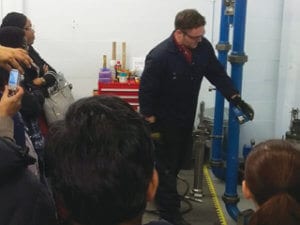
James Taylor demonstrates the High pressure mechanical retrieval tool.
The April meeting, held on Tuesday 25th, had 40 attendees from local companies, and considered advances in Cathodic Protection, looking at Simulation Techniques to help assess CP Current Output of Buried Subsea Pipeline Anodes from Field Gradient Measurements, with a most interesting presentation by Tim Froome of Beasy. The branch evening event followed the annual Aberdeen meeting of the Marine Corrosion Forum, enthusiastically chaired by Phil Dent.
Beasy based in Southampton, serve a wide industry base and focus specifically on how CP field distribution modelling can help better inform our understanding of (often very complex) cathodic protection behaviour and to help engineers assess mitigations and improve the CP design to be implemented. The application of their specialist software was very effectively demonstrated throughout the evening, showing the use of advanced 3D Graphics to illustrate CP current flows under a range of different conditions such as buried CP current sources (sacrificial anodes), local current activity occurring around pipeline coating defects, long range current flows, vertical current distributions and demonstrations of shielding effects / possible CP under-protection at some sites. The paper very usefully complemented an earlier one given by Tim on CP effects at Crevices and Voids at the afternoons MCF Event.
Tim showed how the modelling software can assist in both determining the overall CP system performance and ensuring adequate protective current distribution, as well as assisting in determining the overall CP system life and the likely relative consumption of CP system anodes.
Many questions from the audience were forthcoming including the future integration of the CP Models with established surveys methods used by major subsea survey contractors, so as to make the best use of gathered CP data and to optimize reporting for the CP Systems owners.
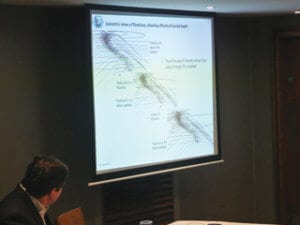
Modelling of CP current flowlines is clearly explained by the speaker.
The CP Flowline phenomenon aroused great interest amongst gathered delegates and the speaker explained that Beasy are intending to develop these relationships forward in the future, so as to assist the subsea industry and the extensive Marine CP markets.
For information about the Aberdeen branch activities please contact our branch secretary, Frances Chalmers, ICorrABZ@gmail.com, alternatively a calendar of local events of interest to corrosion professionals in the Aberdeen area and the opportunity to sign up to the branch mailing list is available at https://sites.google.com/site/icorrabz/home
Aberdeen Branch have also established their new Media Centre, which can be found at https://www.linkedin.com/in/aberdeen-icorr/recent-activity/
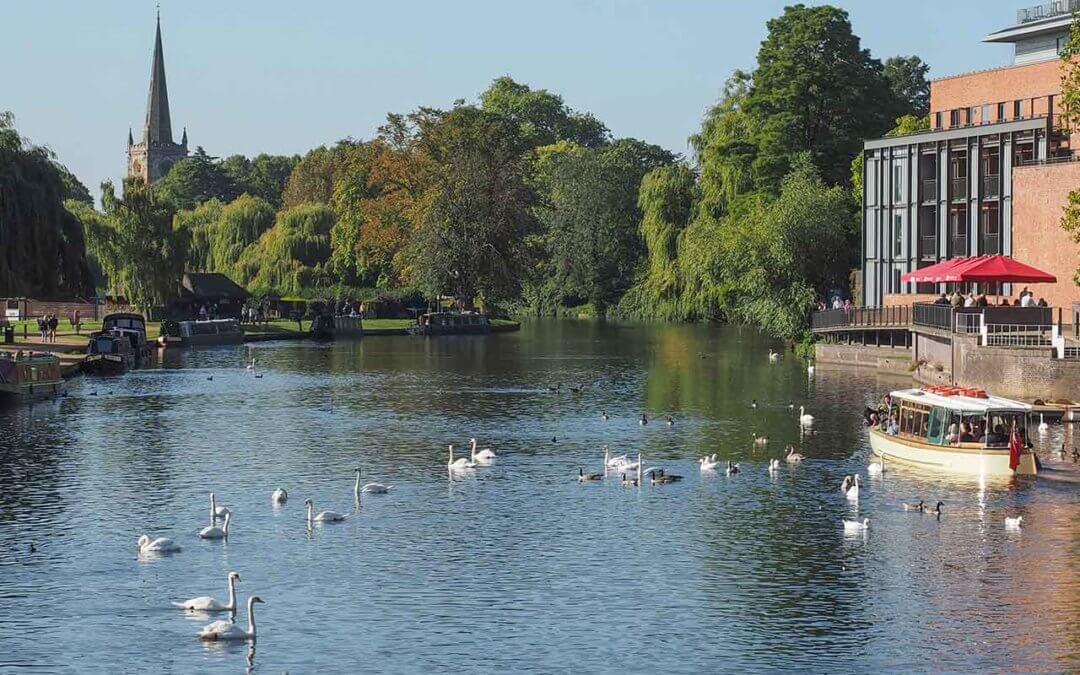
Latest News
The 2017 CEOCOR Congress in Luxembourg was a great success, both technically and socially. The venue was excellent, and the superb Congress dinner was held on the Princess Marie-Astrid boat on the Moselle river, famous for the signing ceremony of the EU Schengen agreement! Thanks must go to our friends in Luxembourg.
Planning for the 2018 CEOCOR Congress in Stratford-upon-Avon, is well underway. In addition to the technical presentations and exhibition, there will be a Partner’s Programme, including visits to Shakespeare’s birthplace, Anne Hathaway’s Cottage, behind the scenes at the Royal Shakespeare Theatre, and to a nearby stately home.
A sponsorship programme has been developed which offers a significant opportunity for the UK (and elsewhere) buried pipeline community to participate. The principal
or Platinum Sponsorship has already been taken up by National Grid, the sole owner and operator of the high pressure gas transmission infrastructure in the UK. Cathodic Protection Co. Ltd. from Grantham has taken one of the Gold Sponsorships, and will also sponsor the BBQ and Jazz evening. Other sponsorship packages are also available and details of these can be found on the conference website, www.ceocor2018.com. Those companies wishing to secure sponsorship at the 2018 CEOCOR Congress need to be quick, as places are filling-up fast.
Conference programme, registration details, hotel package, partner’s programme and news will all be available on the website, which will be regularly updated.
Latest News
The first Young ICorr Social was held on the 20th April at the Prince of Wales Feathers Pub in London, and a very enjoyable evening was had by all. This was planned as a networking event to help launch Young ICorr in London, and was attended by both members and non-members of the Institute of Corrosion. Young ICorr is aimed at young professionals (35 and under) who are interested in, or working in, the field of corrosion.
To hear about future networking and speaking events, please join the Young ICorr LinkedIn page at tinyurl.com/youngicorr (or search for “Young ICorr”). For those who do not use LinkedIn, but wish to be kept updated with Young ICorr news and events, please send an email to Chris.Bridge@uk.bp.com t


